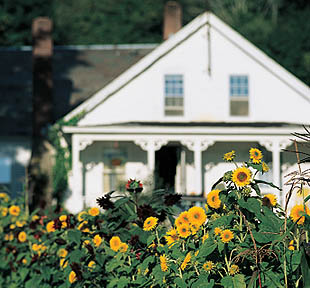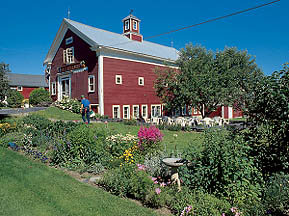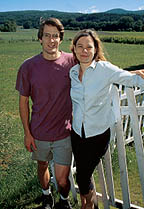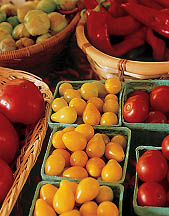| |

A
New Generation on the Farm
While small farms
are fast becoming an endangered species in Vermont, a number of farmers
look to innovation and diversification to resist the tide. On the following
pages, Vermont Quarterly visits four farms worked by young alumni united
by their love of farming and commitment to preserving the state’s
working landscape.
Lilac
Ridge Farm
Amanda Thurber ’94
Ross Thurber ’96
As Ross and
Amanda Thurber walk the back pasture of their Lilac Ridge Farm, nine-month-old
daughter Isabella bumping along contented in an all-terrain stroller,
they consider what makes this farm work.
“A diversiÖed operation isn’t for everyone,” Ross says,
“but it Öts here. A larger dairy farm may make sense in Addison County,
but we like this spot, this farm, and we need to work with the natural
resources at hand.”
It is not hard to understand why these young alumni (Ross ’96, Amanda
’94) of UVM’s College of Agriculture and Life Sciences would
like this spot. Family ties are strong here. In the mid-1930s, Ross’s
grandfather bought the seventy-Öve acres at the core of the farm. His
parents, Stuart ’61 and Beverley, carried on the family farming tradition
and welcomed Amanda and Ross into the business in 1996.
 The
attractions of the land are strong as well. Beautiful and peaceful, Lilac
Ridge is a 600-acre mix of woods and open land just a few miles west of
Brattleboro. Sunflowers, part of the market garden business, grow alongside
the dirt road leading to the farmhouse. Behind the flowers are three acres
with everything from artichokes to broccoli, cucumbers and mesclun. The
pastures, grazed by a mixed herd of sixty Holstein and Brown Swiss, roll
up the hillside leading to the sugarhouse and the hardwood forests beyond. The
attractions of the land are strong as well. Beautiful and peaceful, Lilac
Ridge is a 600-acre mix of woods and open land just a few miles west of
Brattleboro. Sunflowers, part of the market garden business, grow alongside
the dirt road leading to the farmhouse. Behind the flowers are three acres
with everything from artichokes to broccoli, cucumbers and mesclun. The
pastures, grazed by a mixed herd of sixty Holstein and Brown Swiss, roll
up the hillside leading to the sugarhouse and the hardwood forests beyond.
Ross and Amanda met as UVM students. Their relationship clicked immediately,
even before they knew of their mutual interest in farming. Ross smiles
and says, “So, even if we have to give this up and reincarnate ourselves
as Önancial analysts in Boston, we’ll still be married.”
Amanda grew up in suburban Cleveland but has farming roots that stretch
back to her grandparents on the plains of Nebraska. An agriculture-centered
high school summer camp in Vermont piqued her interest in both the state
and working on the land.
Ross credits his decision to stay with the family farm to his parents.
“I was never pushed,” he says. “They believed that I needed
to come to my own terms with whether I wanted to be a farmer.”
It has been a busy four years for the Thurbers. They’ve renovated
their space in the farmhouse; started up the market garden business that
sells to area restaurants, food co-ops and at the Brattleboro area farmer’s
market; re-built the sugarhouse; and constructed conservation lanes to
slow soil erosion. Soon, their new dairy barn will be framed, its posts,
beams and pegs cut from their own hemlock timber.
Coupled with the diversity of pursuits at the Lilac Ridge Farm is a diversity
of talents among this extended farm family. Amanda heads the market garden
operation. Beverley is business manager for the farm and assists with
the Christmas tree farm and market garden. Ross and Stu run the dairy.
Ross manages the forest resource.
“We all get along really well,” Amanda says. “That’s
testament to Ross’s mom and dad. They truly opened up the business
to us and have never said, ‘That’s a crazy idea.’”
Lilac Ridge received the state’s Natural Resources Conservation Farm
of the Year award in 1997, recognizing the farm for being both “environmentally
sound and economically stable.” In the past year, the family sold
the development rights for their land to the Vermont Land Trust, a major
step toward assuring that the careful stewardship practiced by three generations
of Thurbers on this land will continue.
Willow Hill Farm
Willow Smart ’92
David Phinney
For a Öne food producer, kudos from Martha Stewart are
akin to a sort of blessing. Willow Smart ’92 and her husband, David
Phinney, have been making their organic sheep cheese for the past several
years to steadily growing recognition from the likes of Stewart, New York
Times food critics, American Cheese Society judges, some of the top restaurants
and Öne food shops in the country, and an ever-widening circle of loyal
customers at Burlington’s Farmers’ Market.
 “I’m
obsessesed” when it comes to the art and science of making sheep
cheese, Smart admits. She has honed her skill through self-study and trial
and error, building on her UVM degree in plant and soil science. “Value-added”
are key words for the couple on their Willow Hill Farm in Milton. The
equation: sheep milk sells for 68 cents a pound; sheep cheese, more than
$16. “I’m
obsessesed” when it comes to the art and science of making sheep
cheese, Smart admits. She has honed her skill through self-study and trial
and error, building on her UVM degree in plant and soil science. “Value-added”
are key words for the couple on their Willow Hill Farm in Milton. The
equation: sheep milk sells for 68 cents a pound; sheep cheese, more than
$16.
The work that goes into adding that value is painstaking, precise, and
typiÖed by 10-14 hour work days.
One measure is Willow Hill’s new cave for aging the cheese, which
Smart and Phinney are proud to show off. Carved out of a rock ledge, the
cave is nearly part of the natural landscape itself. Inside, the structure
maintains temperature and humidity levels that resemble the fabled Roquefort
caves, fostering the natural molds that will give the cheese the complexity
of flavors that cheesemaking is all about.
The solar-powered earth shelter is Phinney’s handiwork; his wife
credits him with being “MacGyver-like” in his ingenuity around
the farm. And he is equally admiring of and quietly deferential to her
skill and dedication to cheesemaking. Clearly, this is a team operation.
Love and work lead people to interesting places, particularly when they’re
linked, and a mold-friendly cheese cave ranks right up there. Smart is
the eighth generation of a Hawaiian beef ranching family; Phinney is a
self-described “IBM brat” who grew up in Milton. The two met
when they attended the University of Central Florida.
 Smart
had got a taste for northeast living while she was a student at Ithaca
College, and Phinney had a long-standing yen for the self-sufficient lifestyle
that farming offered. In 1991, they bought an abandoned farm in Milton
where the closest thing to a cash crop on the four-hundred acres was the
three-foot high goldenrod growing in the meadows. Smart
had got a taste for northeast living while she was a student at Ithaca
College, and Phinney had a long-standing yen for the self-sufficient lifestyle
that farming offered. In 1991, they bought an abandoned farm in Milton
where the closest thing to a cash crop on the four-hundred acres was the
three-foot high goldenrod growing in the meadows.
They’ve put the land back to work and built their business with an
eye for diversiÖcation. In addition to sheep cheese, they sell berries,
flowers, and vegetables and have plans for a Christmas tree farm if the
deer will cooperate and go easy on the young trees. They also see potential
for sugaring and opening up trails for cross- country skiing.
As their sheep graze in the pasture, Rhode Island Reds follow the animals,
eating bugs and helping to control parasites, and the farmers rotate grazing
pastures frequently to keep the animals on clean ground. A guardian llama
grazes alongside, feisty all-natural protection against coyotes. Whichever
direction Phinney and Smart take the Willow Hill Farm, it is certain that
an organic ethic and the health of the land will guide them.
“We want to leave the land better than we found it,” Smart says,
“That is the goal of stewardship. If we lose open land, we lose what
draws people to this state – it is not only an economic loss but
a great loss of beauty.”
Boyden Valley
Dave Boyden ’91
Linda Rondeau Boyden
 Coming
over a rise on Route 15, a postcard northern Vermont panorama comes into
view – green hills rolling up to the rugged flank of Mt. MansÖeld,
red barns and Holsteins, a bend of the Lamoille River, sandy knolls strung
with grape vines…Wait, let’s try that again. Yes, vineyards
do seem out of place in this picture, standing out like the pig in the
tree on a child’s “What Doesn’t Belong Here” activity
page. It is an unusual Öt, but one that makes sense in the new order at
the Boyden Valley Winery & Farm in Cambridge, which blends traditional
Vermont agriculture with new approaches to specialty foods and agritourism.
Dave Coming
over a rise on Route 15, a postcard northern Vermont panorama comes into
view – green hills rolling up to the rugged flank of Mt. MansÖeld,
red barns and Holsteins, a bend of the Lamoille River, sandy knolls strung
with grape vines…Wait, let’s try that again. Yes, vineyards
do seem out of place in this picture, standing out like the pig in the
tree on a child’s “What Doesn’t Belong Here” activity
page. It is an unusual Öt, but one that makes sense in the new order at
the Boyden Valley Winery & Farm in Cambridge, which blends traditional
Vermont agriculture with new approaches to specialty foods and agritourism.
Dave
Boyden ’91 joins his brother Mark ’88 as the fourth generation
of their family to farm this stretch of land that totals some seven hundred
acres.
While Mark works with his father on the family dairy operation and crops,
Dave and his wife, Linda Rondeau Boyden, have stayed on the farm but taken
a less traditional path with their winery and retail shop housed in a
125-year-old renovated carriage barn.
Linda, a Montreal native, met Dave when he was renovating the barn and
she she was lost and seeking directions. Eighteen months later they were
married. “There’s a certain fate to the place,” Boyden
says with a smile. “These things happen for a reason.”
There does seem to be a certain serendipity to a place where a Vermont
farm boy gets interested in wine-making, and the family farm is blessed
with quick-draining sandy soil and benches of gravel well-suited to growing
grapes. Vermont is not big wine country and probably never will be, Boyden
acknowledges. He has no Napa Valley delusions, but he draws inspiration
from wineries across the Canadian border. “If they can do it in Quebec,
why not here?” Boyden says.
Dave Boyden didn’t grow up dreaming of growing grapes instead of
hay. He earned his UVM degree in small business with a vague idea that
he wanted to start his own business. An avid skier and rock climber, Boyden
led the good life for six years in the Sierras and Rockies, paying the
bills with work on ski patrol and carpentry. Even during those relatively
footloose years, his ties to Vermont farming were strong; he returned
to help on the Boyden Farm during sugaring season.
 Dave’s
interest in wine and wine making were growing at the same time he was
getting serious about starting his own business. His sister-in-law, a
native of New York’s wine country, suggested that vineyards just
might work on the Boyden Farm. “It meshed with the farm and it just
made sense,” Dave Boyden says. There is also some family heritage
wrapped up in all of this — according to family legend, Boyden’s
great uncle was a good hand at making hard cider during Prohibition. Dave’s
interest in wine and wine making were growing at the same time he was
getting serious about starting his own business. His sister-in-law, a
native of New York’s wine country, suggested that vineyards just
might work on the Boyden Farm. “It meshed with the farm and it just
made sense,” Dave Boyden says. There is also some family heritage
wrapped up in all of this — according to family legend, Boyden’s
great uncle was a good hand at making hard cider during Prohibition.
Apples, pears, rhubarb, cranberries, and, of course, grapes are among
the ingredients in the more than thirty thousand bottles of wine that
Boyden produces annually. By many measures, they’re doing it well.
Boyden Valley has won nearly twenty competitions in the eastern U.S. and
Canada, and took a bronze medal in a Napa Valley competition.
Consumers have taken to the product as well. Skiers come down the mountain
from Smuggler’s Notch and busloads of tourists stop on a regular
basis. A September harvest festival at the farm now draws more than two
thousand people. “We’ve been careful in how we’ve grown,”
Boyden says.
At a farm that gives new life to old dairy tanks as vessels for wine-making,
one gets the sense that this is a business that is careful, thrifty, and
just plain smart in old ways and new.
The Intervale
Erin Hanley ’91
Over the past twenty years, Burlington has steadily reclaimed an area
known as the Intervale, the lowlands bordering the Winooski River as it
winds the Önal miles to Lake Champlain. This ragged northern edge of the
city was a Önal resting place for abandoned cars and refrigerators, commonly
regarded as Öelds where danger lurked in the weeds as well. With leadership
from The Intervale Foundation, the city has reinvented the area for recreation,
business, and has plans for an innovative eco-industrial park. But agriculture
is the heritage and remains the core of pursuit for this land.
Appropriate in a city known for its populist politics, much of the farming
in the Intervale today is open, participatory, and a hands-on process.
It is home to a number of operations that fall under the umbrella heading
of community-supported agriculture, or CSAs as they’re commonly called.
 The
largest and oldest of the ventures is the Intervale Community Farm, established
in 1991. For the past Öve years, Erin Hanley ’91 has been a part
of the effort; as assistant manager she joins Andy Jones, farm manager,
as the two full-time staff working the twenty-nine acres the farm rents
from the Intervale Foundation. The
largest and oldest of the ventures is the Intervale Community Farm, established
in 1991. For the past Öve years, Erin Hanley ’91 has been a part
of the effort; as assistant manager she joins Andy Jones, farm manager,
as the two full-time staff working the twenty-nine acres the farm rents
from the Intervale Foundation.
A CSA such as the Intervale Community Farm operates with the Önancial
support of members whose dues gain them not only fresh, organic fruits,
vegetables, and flowers, but a real role in the life of a working farm.
The Intervale Farm has a membership of roughly four-hundred households,
or about one-thousand people.
Hanley doesn’t come to the farming life with traditional credentials,
having earned her UVM degree in history and poetry. But she brings a long-standing
passion for gardening and a commitment to the philosophy underpinning
a CSA.
Clad in brown overalls and a wide-brimmed straw hat, Hanley bends to clip
squash from the vine and tosses them gently into a pile. She pauses from
the work to consider the particular appeal of a CSA.
“It’s really important that people be able to come to the farm
and see what a brussel sprout looks like when it is on the stalk before
it ends up in a box covered with cellophane,” Hanley says. “They
can have the experience of picking a bouquet of flowers or a bunch of
herbs for a dinner they’ll make that evening. It’s kind of like
having a garden without doing the work, but knowing that the people growing
it are really trustworthy.”
 With
her humanities focus, Hanley didn’t get to know UVM ag professors
as an undergrad; she’s getting the chance now. Faculty such as Wendy
Sue Harper and Bill Murphy bring classes to tour the operations in the
Intervale, and UVM students have worked apprenticeship/internships through
the university’s Center for Sustainable Agriculture. With
her humanities focus, Hanley didn’t get to know UVM ag professors
as an undergrad; she’s getting the chance now. Faculty such as Wendy
Sue Harper and Bill Murphy bring classes to tour the operations in the
Intervale, and UVM students have worked apprenticeship/internships through
the university’s Center for Sustainable Agriculture.
Hanley and Jones encourage members to become as involved as they can.
That can mean spending enough hours working in the Öelds to receive a
reduced membership fee or taking part in work parties, horse-drawn carriage
rides, or potluck dinners that build the strong sense of community around
the place. Whatever the level of involvement, Hanley notes, the end product
is “helping people have a closer relationship to where their food
comes from.”
Looking across the Öelds, Hanley says, “The Intervale offers all
of this open land with tremendous potential to supply a good percentage
of the food for this local area. That’s what makes this area very
compelling.” VQ
Ellie Pope ’01 contributed to this story.
|


